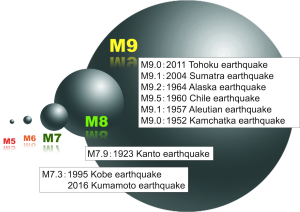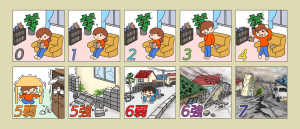1.2 Difference between seismic intensity and magnitude, which are often confused
*The contents may be subject to change without prior notice.
K. Z. Nanjo and K. Oike
NaDiR, Global Center for Asian and Regional Research, University of Shizuoka
While the terms “magnitude” and “seismic intensity” are widely used, they are often incorrectly understood. “Magnitude” (1) is the size of an earthquake itself (Fig. 1-5). It is also a measure of the amount of energy (1) released during an earthquake. Energy is proportional to 101.5M, where M is magnitude, so an increase of magnitude by 2 indicates the release of 1,000 (=103) times more energy. As well, an increase of magnitude by 1 results in the release of about 32 times more energy, because 101.5×1 is almost equal to 32. Generally, the larger the magnitude, the larger the area and amount of slippage that occurs underground. When slippage causes the seabed to move vertically and the sea level to rise or fall, a tsunami will result. Large-magnitude earthquakes occurring near the seabed are considered to be more likely to cause larger vertical movement of the seabed and generate a huge tsunami, than small-magnitude earthquakes.

Fig. 1-5: Each ball represents the amount of energy released during an earthquake by magnitude (M). An increase of magnitude by 1 indicates a 32-times increase in the volume of a ball, and an increase by 2 indicates a 1,000-times increase. An M7 earthquake releases 1,000 times more energy than an M5 earthquake, and an M9 earthquake releases a million times (1,000 x 1,000) more energy than an M5 earthquake. For reference, the 1995 Kobe earthquake and the 2016 Kumamoto earthquake both recorded M7.3, while the 1923 Kanto earthquake that hit Tokyo recorded M7.9. The difference in the size of the balls will help you imagine how devastating an M9 earthquake can be. The original of this figure was created by DUMA Inc., and words and/or phrases appeared in it were translated into English.
On the other hand, “seismic intensity” is the measure of ground shaking produced by an earthquake at a specific location. In details of earthquake mechanism, the grinding of the rock along the fault, namely an earthquake, generates seismic waves that radiate outward, and when the waves reach the earth’s surface, they shake the ground. Even if the magnitude of an earthquake is small, the shaking is strong near the epicenter. Similarly, even if the magnitude is large, the shaking is weak far away from the epicenter (Fig. 1-6).

Fig. 1-6: How seismic intensity is related to magnitude. This figure was modified from that in Shikoku Regional Development Bureau (2).
Earthquakes that make the news are those that we can feel, whose magnitude is somewhere between 3 and 9 at the largest. Small earthquakes of zero and even negative magnitude are also recorded. Magnitude can be as large as 10, but such huge earthquakes have never been observed. In Japan, seismic intensity is represented by a single-digit number (Fig. 1-7), and this seems to cause the confusion with magnitude. The Japanese seismic intensity scale (3) ranges from 0 to 7; there is no −1 or 8 intensity. Intensity higher than 7 is not defined, so no matter how strong and damaging the shaking is, the intensity is classified as 7. Intensity levels 5 and 6 are each divided into “Lower” and “Upper” subcategories, making 10 intensity levels in total.

Fig. 1-7: How seismic intensity used in Japan is related to shaking felt. “5弱” means “5 Lower”. Similarly, “5強”, “6弱”, and “6強” mean “5 Upper”, “6 Lower”, and “6 Upper”, respectively. This figure was modified from that in JMA (3).
There are three important things to note concerning seismic intensity. First, this seismic intensity scale is used in Japan only, and is not understood overseas. Namely, the intensity scale that we use in Japan is called the Japan Meteorologilca Agency (JMA) Seismic Intensity Scale (3). For example, if you say “I experienced an earthquake of intensity 7” to your American friends, they can guess the shaking was strong, but will not think the earthquake was so powerful that you could not remain standing and move without crawling or you might be thrown through the air, because the U.S. uses the modified Mercalli intensity scale (4) which ranges from 1 to 12. Second, with an earthquake of greater than intensity 6 Lower, it is impossible to remain standing (Fig. 1-7); an earthquake of this intensity can cause damage in your neighborhood. Third, pay attention to small earthquakes of intensity 2 or 3, where some people may feel the shaking but other may not. If you are awakened by sudden shaking at night and tell your friend about it the next morning, but the friend says they didn’t notice it at all and kept sleeping. Beware! You might have woken up not because you are more sensitive to shaking, but because your house is in poor condition or is built on earthquake-prone ground. This should encourage you to inspect the durability and safety of your house and perhaps improve its earthquake resistance. This way, you can make good use of small earthquakes that occur frequently.
Sources and references
- Earthquake Magnitude, Energy Release, and Shaking Intensity(U.S. Geological Survey)
- What is the difference between magnitude and seismic intensity? (Shikoku Regional Development Bureau) (in Japanese)
- About seismic intensity (JMA) (in Japanese)
- The Modified Mercalli Intensity Scale (U.S. Geological Survey)